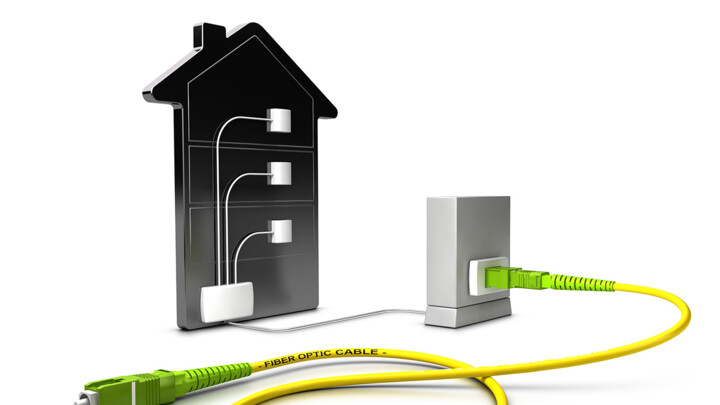Using Fiber to the Edge to Cut the Carbon
Piers Benjamin illustrates how Corning saved energy and money by installing FTTE in their sustainably-built global HQ.

In June 2021, the EU put its 2050 climate-neutral target into law. With the construction sector accounting for over a third of all annual greenhouse gas emissions globally, there is a lot of work ahead for building designers, architects, manufacturers, and consultants to reach net-zero.
A large part of the emissions in this sector has resulted from operational carbon or resultant emissions from energy and fuel consumption, with 11 percent from building materials and construction. Although focusing on operational carbon has resulted in technological efficiency advances and environmental policies, it only represents part of the net-zero solution.
The missing piece here is the embodied carbon associated with raw material extraction, manufacturing, delivery, and construction methods, as well as end-of-life disposal or recycling of building infrastructure. It is imperative, therefore, that methods to reduce this embodied carbon are designed into the building infrastructure early on, in order to have a meaningful impact. This includes network infrastructure that supports the ever-increasing technologies being deployed in buildings.
More devices = more data and more power
In parallel, spurred by the explosion of the Internet of Things (IoT), buildings are increasingly becoming more and more connected, with the number of devices powered in our spaces going through the roof. If you think about all the technologies being utilized today in buildings, there are WiFi or cellular data networks including 5G; surveillance cameras and access control, heating and ventilation control, plus IoT sensors such as those for air quality, occupancy, asset tracking, and location. And that’s just to name a few.
These advancements require a future-ready backbone to leverage IoT and efficiently manage assets, resources, and services. This lends itself not only to reduced energy consumption but improvements to the overall occupant experience. A future-limiting factor of IoT technology within smart buildings will be bandwidth, especially when increased network agility will be needed to support integrated artificial intelligence.
Enter, FTTE
With the ever-increasing number of devices, the legacy methods of deploying a Local Area Network (LAN) in buildings (where multiple runs of copper category cables are connected to each and every device) are starting to reach their limits both in terms of bandwidth and distance.
Cat 6A and even Cat 7, for example, have maximum bandwidths of 10Gbps at 100-meter distances. While Cat 8 can go to 40Gbps, its distance is reduced to just 30 meters and, as such, is limited to DC applications. Fiber to the Edge (FTTE) architecture, on the other hand, is more streamlined, future-flexible, and sustainable, with a much-reduced carbon footprint. A building-wide FTTE network supports over 1,000 times more bandwidth than copper, with the added benefit of lower operational and embodied carbon (measured as Global Warming Potential in CO2e).
At Corning Optical Communications, we have put this into practice ourselves with an FTTE network up and running at our global headquarters in Charlotte, North Carolina. It has more than 460 fiber runs spanning six floors with a central main distribution frame (MDF) in a single room. A retrospective study has since been completed to holistically assess the impact of FTTE concerning the whole-life carbon emissions of our new headquarters.
The results showed that for the Corning HQ, the estimated energy savings were more than 68,000 kWh per year. These savings have a direct financial impact on the bottom line, with a simple payback in three years and a 153 percent return on investment. In addition to operational savings, the FTTE network was 29 percent less expensive to install than a legacy copper network.
This is because it is fully optical, with optical fiber carrying all data transmission, allowing the network to operate from a central equipment room, or MDF. This eliminates the need for intermediate distribution frames (IDFs) and reduces power and cooling expenses in the process. The extremely high bandwidth enabled by an FTTE architecture makes it possible to wirelessly operate many edge devices, reducing the need for individual wiring and porting.
The takeaway
Crucially, using an FTTE network eliminates the need for separate cabling, which reduces the total amount of cable in the building. Furthermore, it reduces the amount of duct and tray space required to house that cabling. From a materials' perspective, using a composite (hybrid fiber and power) cable in a zone architecture reduces the linear meters of cable by up to 70 percent. For a 16,723m2 building, this equates to 77,075 meters of linear cable. In addition to using less cable, FTTE networks require 40 percent less rack space and significantly fewer IDF closets, further reducing embodied carbon. From an operational perspective, FTTE networks also reduce the energy required for HVAC dramatically, with significantly less power needed to run and cool network electronics.
An FTTE architecture implemented early in the design of a new building, therefore, can result in significant benefits, enabling future-ready flexibility with more network capability. This is especially important with the upcoming rollout of WiFi 7, and the need for up to 40G. All in all, FTTE protects a business’s technology investments while cutting both its carbon footprint and costs of the network.

A white paper on the "Impact of Technology Network Design on Building Sustainability: How a Fiber to the Edge network can reduce carbon footprint" can be downloaded from the Corning website here.
Piers Benjamin joined Corning Optical Communications in 2018, as the EMEA Marketing Manager for In-Building Networks. He has over 14 years' experience in the industry, with past marketing roles including working for a leading UK distributor. At Corning, Piers is responsible for the marketing activities of the traditional LAN and fiber to the edge technologies.
Please note: The opinions expressed in Industry Insights published by dotmagazine are the author’s or interview partner’s own and do not necessarily reflect the view of the publisher, eco – Association of the Internet Industry.





